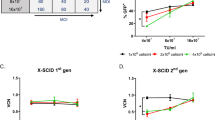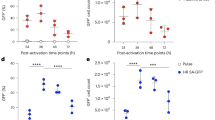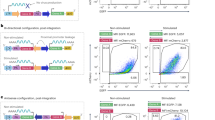Abstract
Several clinical studies of gene-modified T cells have shown limited in vivo function of the cells, immunogenicity of the transgene, and lack of a selective advantage for gene-modified T cells. To address these problems, we developed a lentiviral vector (LV) that provides a selectable, proliferative advantage and potentially decreases immunogenicity for transduced T cells. The bicistronic vector expressed two genes linked with an internal ribosomal entry site. One gene is a variant of the inosine monophosphate dehydrogenase 2, inosine monophosphate dehydrogenase (IMPDHIY), conferring resistance to the immunosuppressive drug mycophenolate mofetil (MMF). The other is a suicide gene, herpes simplex virus thymidine kinase (HSV-TK), rendering proliferating cells sensitive to ablation with ganciclovir, fused to the selectable transmembrane marker ΔCD34 (ΔCD34/TK). Cells transduced with LV-ΔCD34/TK.IMPDHIY were efficiently enriched by immunomagnetic selection for CD34, proliferated in 0.5–5 μM MMF, and were killed by 0.5–25 μg ml−1 ganciclovir. We demonstrate efficient selection and killing of gene-modified cells and suggest LV-ΔCD34/TK.IMPDHIY-transduced T cells could be used to facilitate allogeneic hematopoietic cell engraftment. The expression of IMPDHIY would allow in vivo selection with MMF, and ΔCD34/TK expression would allow rapid and safe elimination of transduced T cells if graft-versus-host disease developed.
This is a preview of subscription content, access via your institution
Access options
Subscribe to this journal
Receive 12 print issues and online access
$259.00 per year
only $21.58 per issue
Buy this article
- Purchase on Springer Link
- Instant access to full article PDF
Prices may be subject to local taxes which are calculated during checkout



Similar content being viewed by others
References
Bonini C, Ferrari G, Verzeletti S, Servida P, Zappone E, Ruggieri L et al. HSV-TK gene transfer into donor lymphocytes for control of allogeneic graft-versus-leukemia. Science 1997; 276: 1719–1724.
Tiberghien P, Reynolds CW, Keller J, Spence S, Deschaseaux M, Certoux J-M et al. Ganciclovir treatment of herpes simplex thymidine kinase-transduced primary T lymphocytes: an approach for specific in vivo donor T-cell depletion after bone marrow transplantation? Blood 1994; 84: 1333–1341.
Garin MI, Garrett E, Tiberghien P, Apperley JF, Chalmers D, Melo JV et al. Molecular mechanism for ganciclovir resistance in human T lymphocytes transduced with retroviral vectors carrying the herpes simplex virus thymidine kinase gene. Blood 2001; 97: 122–129.
Yam P, Jensen M, Akkina R, Anderson J, Villacres MC, Wu J et al. Ex vivo selection and expansion of cells based on expression of a mutated inosine monophosphate dehydrogenase 2 after HIV vector transduction: effects on lymphocytes, monocytes, and CD34+ stem cells. Mol Ther 2006; 14: 236–244.
Allison AC, Eugui EM . Mycophenolate mofetil and its mechanisms of action (Review). Immunopharmacology 2000; 47: 85–118.
Sintchak MD, Fleming MA, Futer O, Raybuck SA, Chambers SP, Caron PR et al. Structure and mechanism of inosine monophosphate dehydrogenase in complex with the immunosuppressant mycophenolic acid. Cell 1996; 85: 921–930.
Lightfoot T, Snyder FF . Gene amplification and dual point mutations of mouse IMP dehydrogenase associated with cellular resistance to mycophenolic acid. Biochim Biophys Acta 1994; 1217: 156–162.
Hodges SD, Fung E, McKay DJ, Renaux BS, Snyder FF . Increased activity, amount, and altered kinetic properties of IMP dehydrogenase from mycophenolic acid-resistant neuroblastoma cells. J Biol Chem 1989; 264: 18137–18141.
Plautz G, Nabel EG, Nabel GJ . Selective elimination of recombinant genes in vivo with a suicide retroviral vector. New Biol 1991; 3: 709–715.
Martin PJ . Overview of hematopoietic cell transplantation immunology. In: Blume KG, Forman SJ, Appelbaum FR (eds). Thomas' Hematopoietic Cell Transplantation. Blackwell Publishing Ltd: Oxford, UK, 2004 pp 16–30.
Mavilio F, Ferrari G, Rossini S, Nobili N, Bonini C, Casorati G et al. Peripheral blood lymphocytes as target cells of retroviral vector-mediated gene transfer. Blood 1994; 83: 1988–1997.
Rettig MP, Ritchey JK, Meyerrose TE, Haug JS, DiPersio JF . Transduction and selection of human T cells with novel CD34/thymidine kinase chimeric suicide genes for the treatment of graft-versus-host disease. Mol Ther 2003; 8: 29–41.
Sandrin V, Boson B, Salmon P, Gay W, Negre D, Le Grand R et al. Lentiviral vectors pseudotyped with a modified RD114 envelope glycoprotein show increased stability in sera and augmented transduction of primary lymphocytes and CD34+ cells derived from human and nonhuman primates. Blood 2002; 100: 823–832.
Spencer HT, Sleep SE, Rehg JE, Blakley RL, Sorrentino BP . A gene transfer strategy for making bone marrow cells resistant to trimetrexate. Blood 1996; 87: 2579–2587.
Davis BM, Roth JC, Liu L, Xu-Welliver M, Pegg AE, Gerson SL . Characterization of the P140 K, PVP(138–140)MLK, and G156A O6-methylguanine-DNA methyltransferase mutants: implications for drug resistance gene therapy. Hum Gene Ther 1999; 10: 2769–2778.
Davis BM, Koc ON, Gerson SL . Limiting numbers of G156A O(6)-methylguanine-DNA methyltransferase-transduced marrow progenitors repopulate nonmyeloablated mice after drug selection. Blood 2000; 95: 3078–3084.
Riddell SR, Elliott M, Lewinsohn DA, Gilbert MJ, Wilson LA, Manley SA et al. T-cell mediated rejection of gene-modified HIV-specific cytotoxic T lymphocytes in HIV-infected patients. Nat Med 1996; 2: 216–223.
Morris JC, Conerly M, Thomasson B, Storek J, Riddell SR, Kiem H-P . Induction of cytotoxic T-lymphocyte responses to enhanced green and yellow fluorescent proteins after myeloablative conditioning. Blood 2004; 103: 492–499.
Georges GE, Storb R, Brunvand MW, Kiem H-P, Moore PF, Malik P et al. Canine T cells transduced with a herpes simplex virus thymidine kinase gene: a model to study effects on engraftment and control of graft-versus-host disease. Transplantation 1998; 66: 540–544.
Georges GE, Storb R, Bruno B, Brodie SJ, Thompson JD, Taranova AG et al. Engraftment of DLA-haploidentical marrow with ex vivo expanded, retrovirally transduced cytotoxic T lymphocytes. Blood 2001; 98: 3447–3455.
Berger C, Flowers ME, Warren EH, Riddell SR . Analysis of transgene-specific immune responses that limit the in vivo persistence of adoptively transferred HSV-TK-modified donor T cells after allogeneic hematopoietic cell transplantation. Blood 2006; 107: 2294–2302.
Giaccone L, McCune JS, Maris MB, Gooley TA, Sandmaier BM, Slattery JT et al. Pharmacodynamics of mycophenolate mofetil after nonmyeloablative conditioning and unrelated donor hematopoietic cell transplantation. Blood 2005; 106: 4381–4388.
Horn PA, Morris JC, Bukovsky AA, Andrews RG, Naldini L, Kurre P et al. Lentivirus-mediated gene transfer into hematopoietic repopulating cells in baboons. Gene Therapy 2002; 9: 1464–1471.
Dull T, Zufferey R, Kelly M, Mandel RJ, Nguyen M, Trono D et al. A third-generation lentivirus vector with a conditional packaging system. J Virol 1998; 72: 8463–8471.
Acknowledgements
The research was supported by NIH NCI Grants R01 CA109381, P01 CA78902, R01 DK42716 and ‘Progetto Vita Vitae’, Fondazione CRT. We are grateful to Dr John F DiPersio, Washington University, for providing the ΔCD34/HSV-TK75 fusion gene. We thank Helen Crawford and Bonnie Larson for assistance in preparation of the paper.
Author information
Authors and Affiliations
Corresponding author
Rights and permissions
About this article
Cite this article
Sangiolo, D., Lesnikova, M., Nash, R. et al. Lentiviral vector conferring resistance to mycophenolate mofetil and sensitivity to ganciclovir for in vivo T-cell selection. Gene Ther 14, 1549–1554 (2007). https://doi.org/10.1038/sj.gt.3303018
Received:
Revised:
Accepted:
Published:
Issue Date:
DOI: https://doi.org/10.1038/sj.gt.3303018
Keywords
This article is cited by
-
CD34-based enrichment of genetically engineered human T cells for clinical use results in dramatically enhanced tumor targeting
Cancer Immunology, Immunotherapy (2010)
-
Adoptive cellular immunotherapy for childhood malignancies
Bone Marrow Transplantation (2008)



